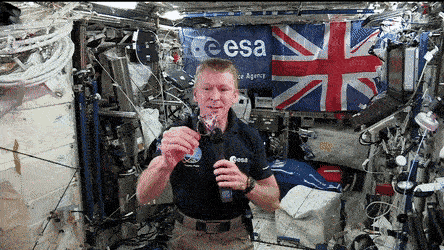There’s no up and down in space, but there is a preferred orientation for the International Space Station and other satellites as they orbit Earth. So what happens when you spin a gyroscope in space?
This is a fun demonstration, and a rare one: ESA astronaut Tim Peake shared what happens in this 2016 video, filmed during his six-month Principia mission. And from the European Space Agency in the video comments:
“The ISS revolves around the Earth on a fixed orbit and pitches to keep its nadir pointing aligned with the local zenith from the Earth surface (i.e. “looks always down”). Once setting the little gyroscope in motion, its rotation axis is fixed in space, while the ISS capsule will turn around it to return to its original orientation in one full revolution about the Earth. If one strapped up by the wall of the ISS she/he would see the gyroscope turn, but the gyroscope has fixed attitude in space (by angular momentum conservation) while the ISS has not, hence it is the ISS that is turning.”
“Attitude control on the ISS is provided by four control moment gyroscopes, located in the Unity module, hosting 100kg wheels spinning at 6600 revolutions per minute, resulting in an angular momentum of 4742.5N*m*s. The wheels are adjusted in a special “pyramid” configuration to provide the four degrees per minute torque that keep the “keel” of the ISS pointing downwards as explained above (the ISS hosts a myriad of antennas and instruments and this is the best scientific and technical solution, not to mention its outreach potential, see e.g. the cupola windows). The mounting allows to generate extra torques too, i.e. equal and opposite to those generated by atmospheric drag, gravity, docking and undocking shocks and orbit boosts.”
“Gyroscopes have limitations of course and the momentum of inertia of the ISS is a huge burden to govern, hence assistance is provided by the Russian control thrusters on the Progress and Zvezda modules. Attitude control changes and full management of the ISS bearing are simulated up to a year in advance following orbital prediction and mission design. Fair enough, the orbit of the ISS is fixed at inclination 51.64deg and 90min period, but the Earth rotates, always offering a changing face to the ISS with different local gravitational features: again the ISS orientation at every period might differ by up to a few degrees and the apparent position of the mini-gyroscope might differ across orbits.”
Watch this excellent video next: Spinning Bike Wheel and Conservation of Angular Momentum.
Then watch more videos about ISS and spinning toys:
• A fidget spinner in space
• Angular momentum demo with a Hoberman Sphere
• Tippe Top – Grand Illusions
• Tops (1969) by Charles and Ray Eames
• The science behind spinning 200 hula hoops at once
Bonus: How A Children’s Toy Led To An Essential Medical Device.
Curated, kid-friendly, independently-published. Support this mission by becoming a sustaining member today.



